Ornette Coleman
Randolph Denard Ornette Coleman (March 9 or 19, 1930 – June 11, 2015)[1] was an American jazz saxophonist, violinist, trumpeter, and composer. In the 1960s, he was one of the founders of free jazz, a term he invented for his album Free Jazz: A Collective Improvisation. His "Broadway Blues" and "Lonely Woman" have become standards and are cited as important early works in free jazz.[2] His album Sound Grammar received the 2007 Pulitzer Prize for Music.[3]
Ornette Coleman | |
|---|---|
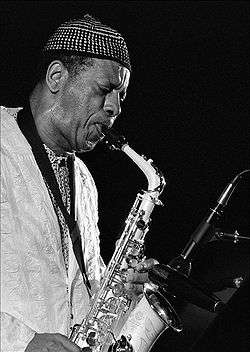 | |
| Background information | |
| Birth name | Randolph Denard Ornette Coleman |
| Born | March 9, 1930 Fort Worth, Texas, U.S. |
| Died | June 11, 2015 (aged 85) New York City |
| Genres | Avant-garde jazz, free jazz, free funk, jazz fusion |
| Occupation(s) | Musician, composer |
| Instruments | Alto saxophone, tenor saxophone, violin, trumpet |
| Years active | 1958–2015 |
| Labels | Atlantic, Blue Note, Verve |
| Associated acts | Don Cherry, Charlie Haden, Bobby Bradford, Scott LaFaro, Billy Higgins, Ed Blackwell, Dewey Redman, Denardo Coleman, Ronald Shannon Jackson, Jamaaladeen Tacuma |
Biography
Early life
Coleman was born on the 9th of March, 1930, in Fort Worth, Texas,[4] where he was raised.[5][6][7]
He attended I.M. Terrell High School, where he participated in band until he was dismissed for improvising during "The Washington Post" march. He began performing R&B and bebop on tenor saxophone and started The Jam Jivers with Prince Lasha and Charles Moffett.[7]
Eager to leave town, he accepted a job in 1949 with a Silas Green from New Orleans traveling show and then with touring rhythm and blues shows. After a show in Baton Rouge, Louisiana, he was assaulted and his saxophone was destroyed.[8]
He switched to alto saxophone, which remained his primary instrument, first playing it in New Orleans after the Baton Rouge incident. He then joined the band of Pee Wee Crayton and traveled with them to Los Angeles. He worked at various jobs, including as an elevator operator, while pursuing his music career.[9]
In California he found like-minded musicians such as Ed Blackwell, Bobby Bradford, Don Cherry, Charlie Haden, Billy Higgins, and Charles Moffett.[10][11] He recorded his debut album, Something Else!!!! (1958) with Cherry, Higgins, Walter Norris, and Don Payne.[12] During the same year he belonged briefly to a quintet led by Paul Bley that performed at a club in New York City.[10] By the time Tomorrow Is the Question! was recorded soon after with Cherry, Higgins, and Haden, the jazz world had been shaken up by Coleman's alien music. Some jazz musicians called him a fraud, while conductor Leonard Bernstein praised him.[11]
1959: The Shape of Jazz to Come
In 1959 Atlantic released The Shape of Jazz to Come. According to music critic Steve Huey, the album "was a watershed event in the genesis of avant-garde jazz, profoundly steering its future course and throwing down a gauntlet that some still haven't come to grips with."[13] Jazzwise listed it No. 3 on their list of the 100 best jazz albums of all time.[14]
Coleman's quartet received a long – and sometimes controversial – engagement at Five Spot jazz club in New York City. Leonard Bernstein, Lionel Hampton, and Modern Jazz Quartet were impressed and offered encouragement. Hampton asked to perform with the quartet; Bernstein helped Haden obtain a composition grant from the John Simon Guggenheim Memorial Foundation. But trumpeter Miles Davis said Coleman was "all screwed up inside",[15][16] although he recanted this comment and became a proponent of Coleman's innovations.[17]
Coleman's early sound was due in part to his use of a plastic saxophone. He bought a plastic horn in Los Angeles in 1954 because he was unable to afford a metal saxophone, though he didn't like the sound of the plastic instrument at first.[7]
On the Atlantic recordings, Coleman's sidemen in the quartet are Cherry on cornet or pocket trumpet; Charlie Haden, Scott LaFaro, and then Jimmy Garrison on bass; and Higgins or his replacement Ed Blackwell on drums. The complete recordings for the label were collected on the box set Beauty Is a Rare Thing.[10]
1960: Free Jazz
In 1960, Coleman recorded Free Jazz: A Collective Improvisation, which featured a double quartet, including Don Cherry and Freddie Hubbard on trumpet, Eric Dolphy on bass clarinet, Haden and LaFaro on bass, and both Higgins and Blackwell on drums.[18] The album was recorded in stereo with a reed/brass/bass/drums quartet isolated in each stereo channel. Free Jazz was, at nearly 40 minutes, the longest recorded continuous jazz performance to date[19] and was one of Coleman's most controversial albums. The music features a regular but complex pulse, one drummer playing "straight" while the other played double-time; the thematic material is a series of brief, dissonant fanfares. A series of solo features for each member of the band, but the other soloists are free to chime in as they wish.[20] In the January 18, 1962 issue of Down Beat magazine, in a review titled "Double View of a Double Quartet," Pete Welding gave the album five stars while John A. Tynan rated it zero stars.[21] Time has been kinder to the album, though, with AllMusic listing it as one of "20 Essential Free Jazz albums."[18]
Coleman intended "free jazz" as simply an album title. But his growing reputation placed him at the forefront of jazz innovation, and free jazz was soon considered a new genre, though Coleman has expressed discomfort with the term. Among the reasons he may have disapproved of the term is that his music contains composition. His melodic material, although skeletal, recalls melodies that Charlie Parker wrote over standard harmonies. The music is closer to the bebop that came before it than is sometimes popularly imagined.[22]
1960s–70s: Avant-garde and harmolodic funk
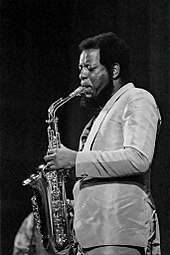
After the Atlantic period and into the early part of the 1970s, Coleman's music became more angular and engaged with the avant-garde jazz which had developed in part around his innovations.[10]
After his quartet disbanded, he formed a trio with David Izenzon on bass and Charles Moffett on drums. He extended the sound of his music, introducing string players and playing trumpet and violin, which he played left-handed. He had little conventional musical technique and used the instruments to make large, unrestrained gestures. His friendship with Albert Ayler influenced his development on trumpet and violin. Charlie Haden sometimes joined this trio to form a two-bass quartet.
Coleman signed with Blue Note and recorded At the Golden Circle Stockholm.[23] In 1966, he recorded The Empty Foxhole with his son, Denardo Coleman, who was ten years old. Freddie Hubbard and Shelly Manne regarded this as an ill-advised piece of publicity on Coleman's part.[24][25] Despite his youth, Denardo Coleman had studied drumming for several years. His technique was unrefined but enthusiastic, owing more to pulse-oriented free jazz drummers like Sunny Murray than to bebop drummers.[23] He became his father's primary drummer in the late 1970s.
Coleman formed another quartet. Haden, Garrison, and Elvin Jones appeared, and Dewey Redman joined the group, usually on tenor saxophone. On February 29, 1968 in a group with Haden, Ed Blackwell, and David Izenzon Coleman performed live with Yoko Ono at Albert Hall. One song was included on the album Yoko Ono/Plastic Ono Band (1970)[26]
He continued to explore his interest in string textures – from Town Hall, 1962, culminating with the Skies of America album in 1972. (Sometimes this had a practical value, as it facilitated his group's appearance in the UK in 1965, where jazz musicians were under a quota arrangement but classical performers were exempt.)
Coleman, like Miles Davis before him, took to playing with electrified instruments. The 1976 funk album Dancing in Your Head, Coleman's first recording with the group which later became known as Prime Time, prominently featured electric guitars. While this marked a stylistic departure for Coleman, the music maintained certain similarities to his earlier work. These performances had the same angular melodies and simultaneous group improvisations – what Joe Zawinul referred to as "nobody solos, everybody solos" and what Coleman called harmolodics – and although the nature of the pulse was altered, Coleman's rhythmic approach was not.
1980s–90s
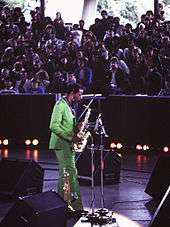
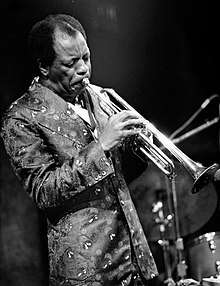
In the 1980s, albums like Virgin Beauty and Of Human Feelings continued to use rock and funk rhythms, sometimes called free funk.[27][28] Jerry Garcia played guitar on three tracks from Coleman's 1988 album Virgin Beauty: "Three Wishes", "Singing in the Shower", and "Desert Players". Coleman joined the Grateful Dead on stage in 1993 during "Space" and stayed for "The Other One", "Stella Blue", Bobby Bland's "Turn on Your Lovelight", and the encore "Brokedown Palace".[29][30] Another collaboration was with guitarist Pat Metheny, with whom Coleman recorded Song X (1985); though released under Metheny's name, Coleman was essentially co-leader (contributing all the compositions).
In 1990, the city of Reggio Emilia in Italy held a three-day "Portrait of the Artist" featuring a Coleman quartet with Cherry, Haden, and Higgins. The festival also presented performances of his chamber music and the symphonic Skies of America.[31] In 1991, Coleman played on the soundtrack for David Cronenberg's Naked Lunch; the orchestra was conducted by Howard Shore.[32] It is notable among other things for including a rare sighting of Coleman playing a jazz standard: Thelonious Monk's "Misterioso". Two 1972 (pre-electric) Coleman recordings, "Happy House" and "Foreigner in a Free Land", were used in Gus Van Sant's 2000 Finding Forrester.[33] He released four records in 1995 and 1996, and for the first time in many years worked regularly with piano players (either Geri Allen or Joachim Kühn).
2000s
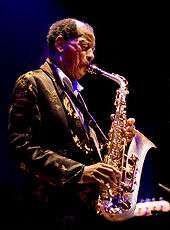
In September 2006 he released a live album titled Sound Grammar with his son, Denardo Coleman, and two bassists, Greg Cohen, and Tony Falanga. This was his first album of new material in ten years and was recorded in Germany in 2005. It won the 2007 Pulitzer Prize for music, Coleman being only the second jazz musician to win the prize.[34]
Jazz pianist Joanne Brackeen stated in an interview with Marian McPartland that Coleman mentored her and gave her music lessons.[35]
Personal life, death, and subsequent material loss
Coleman married poet Jayne Cortez in 1954. The couple divorced in 1964.[36] They had one son, Denardo, born in 1956.[37]
Coleman died of a cardiac arrest at the age of 85 in New York City on June 11, 2015.[1] His funeral was a three-hour event with performances and speeches by several of his collaborators and contemporaries.[38]
On June 25, 2019, The New York Times Magazine listed Ornette Coleman among hundreds of artists whose material was reportedly destroyed in the 2008 Universal fire.[39]
Coleman was dyslexic.[40]
Awards and honors
- Down Beat Jazz Hall of Fame, 1969
- MacArthur Fellowship, 1994
- Praemium Imperiale, 2001
- Dorothy and Lillian Gish Prize, 2004[41]
- Honorary doctorate of music, Berklee College of Music, 2006[42]
- Grammy Lifetime Achievement Award, 2007
- Pulitzer Prize for music, 2007[34]
- Miles Davis Award, Festival International de Jazz de Montréal, 2009[43]
- Honorary doctorate by the Graduate Center, CUNY, 2008[44][45]
- Honorary doctorate of music, University of Michigan, 2010[46]
Discography
In popular culture
McClintic Sphere, a fictional character in Thomas Pynchon's debut novel V. (1963), is an innovative saxophonist modeled on Ornette Coleman.[47][48][49]
Notes
- Ratliff, Ben (June 11, 2015). "Ornette Coleman, Saxophonist Who Rewrote the Language of Jazz, Dies at 85". The New York Times. Retrieved December 16, 2018.
- Hellmer, Jeffrey; Lawn, Richard (May 3, 2005). Jazz Theory and Practice: For Performers, Arrangers and Composers. Alfred Music. pp. 234–. ISBN 978-1-4574-1068-0. Retrieved December 15, 2018.
- "2007 Pulitzer Prizes". Pulitzer.org. Retrieved July 13, 2020.
- Fordham, John (June 11, 2015). "Ornette Coleman obituary". The Guardian. Retrieved December 16, 2018.
- Palmer, Robert (December 1972). "Ornette Coleman and the Circle with a Hole in the Middle". The Atlantic Monthly.
Ornette Coleman since March 19, 1930, when he was born in Fort Worth, Texas
- Wishart, David J. (ed.). "Coleman, Ornette (b. 1930)". Encyclopedia of the Great Plains. Archived from the original on July 7, 2012. Retrieved March 26, 2012.
Ornette Coleman, born in Fort Worth, Texas, on March 19, 1930
- Litweiler, John (1992). Ornette Coleman: the harmolodic life. London: Quartet. pp. 21–31. ISBN 0-7043-2516-0.
- Spellman, A.B. (1985). Four Lives in the Bebop Business (1st Limelight ed.). Limelight. pp. 98–101. ISBN 0-87910-042-7.
- Hentoff, Nat (1975). The Jazz Life. Da Capo Press. pp. 235–236.
- Yanow, Scott. "Ornette Coleman". AllMusic. Retrieved August 14, 2018.
- "Ornette Coleman biography on Europe Jazz Network". Archived from the original on May 2, 2005.
- Jurek, Thom. "Something Else: The Music of Ornette Coleman". AllMusic. Retrieved August 14, 2018.
- Huey, Steve. "The Shape of Jazz to Come". AllMusic. Retrieved August 14, 2018.
- Flynn, Mike (July 18, 2017). "The 100 Jazz Albums That Shook The World". www.jazzwisemagazine.com. Retrieved December 16, 2018.
- Miles Davis, quoted in John Litwiler, Ornette Coleman: A Harmolodic Life (NY: W. Morrow, 1992), 82. ISBN 0688072127, 9780688072124
- Roberts, Randall (January 11, 2015). "Why was Ornette Coleman so important? Jazz masters both living and dead chime in". latimes.com. Retrieved December 16, 2018.
- Kahn, Ashley (November 13, 2006). "Ornette Coleman: Decades of Jazz on the Edge". NPR.org. Retrieved December 16, 2018.
- "Happy 55th: Ornette Coleman, Free Jazz: A Collective Improvisation". Rhino Records. December 21, 2015. Retrieved November 17, 2019.
- Hewett, Ivan (June 11, 2015). "Ornette Coleman: the godfather of free jazz". The Telegraph. Retrieved November 17, 2019.
- Bailey, C. Michael (September 30, 2011). "Ornette Coleman: Free Jazz". All About Jazz. Retrieved November 17, 2019.
- Welding, Pete (January 18, 1962). "Double View of a Double Quartet". DownBeat. 29 (2).
- Howard Reich (September 30, 2010). Let Freedom Swing: Collected Writings on Jazz, Blues, and Gospel. Northwestern University Press. pp. 333–. ISBN 978-0-8101-2705-0.
- Freeman, Phil (December 18, 2012). "Good Old Days: Ornette Coleman On Blue Note". Blue Note Records. Retrieved August 14, 2018.
- Gabel, J. C. "Making Knowledge Out of Sound" (PDF). stopsmilingonline.com. Retrieved August 14, 2018.
- Spencer, Robert (April 1, 1997). "Ornette Coleman: The Empty Foxhole". All About Jazz. Retrieved August 14, 2018.
- Chrispell, James. "Yoko Ono/Plastic Ono Band". AllMusic. Retrieved August 14, 2018.
- Appiah, Anthony; Appiah, Kwame Anthony; Gates, Henry Louis (March 16, 2005). Africana: The Encyclopedia of the African and African American Experience. Oxford University Press. ISBN 9780195170559. Retrieved March 18, 2017.
- Berendt, Joachim-Ernst; Huesmann, Günther (August 1, 2009). The Jazz Book: From Ragtime to the 21st Century. Chicago Review Press. ISBN 9781613746042. Retrieved March 18, 2017.
- Scott, John W.; Dolgushkin, Mike; Nixon, Stu (1999). DeadBase XI: The Complete Guide to Grateful Dead Song Lists. Cornish, New Hampshire: DeadBase. ISBN 1-877657-22-0.
- "Grateful Dead Live at Oakland-Alameda County Coliseum on 1993-02-23". Internet Archive. February 23, 1993.
- "Ornette Coleman: Quartet Reunion 1990". AllAboutJazz.com. January 10, 2011. Retrieved July 13, 2020.
- Mills, Ted. "Howard Shore / Ornette Coleman / London Philharmonic Orchestra: Naked Lunch [Music from the Original Soundtrack]". allmusic.com. Retrieved July 13, 2020.
- "Finding Forrester: Music From The Motion Picture". discogs.com. Retrieved July 15, 2020.
- "Pulitzer Prize winning jazz visionary Ornette Coleman dies aged 85". HeraldScotland. Retrieved December 16, 2018.
- Lyon, David (March 14, 2014). "Joanne Brackeen On Piano Jazz". NPR.org. Retrieved December 16, 2018.
- Rubien, David (October 26, 2007). "Poet Jayne Cortez makes heady music with Ornette Coleman sidemen". sfgate.com. Retrieved July 13, 2020.
- Fox, Margalit (January 3, 2013). "Jayne Cortez, Jazz Poet, Dies at 78". The New York Times. Retrieved December 16, 2018.
- Remnick, David (June 27, 2015). "Ornette Coleman and a Joyful Funeral". The New Yorker. Retrieved December 16, 2018.
- Rosen, Jody (June 25, 2019). "Here Are Hundreds More Artists Whose Tapes Were Destroyed in the UMG Fire". The New York Times. Retrieved June 28, 2019.
- Cullman, Brian; Zabor, Rafi (June 16, 2015). "Two Remembrances of Ornette Coleman". The Paris Review. Retrieved July 21, 2020.
- The Dorothy and Lillian Gish Prize Archived October 6, 2013, at the Wayback Machine, official website.
- "Archived copy". Archived from the original on April 19, 2017. Retrieved April 18, 2017.CS1 maint: archived copy as title (link)
- Montreal Jazz Festival official page Archived May 16, 2010, at the Wayback Machine
- "Press Release: 2008 CUNY Graduate Center Commencement". www.gc.cuny.edu. Retrieved December 16, 2018.
- "CUNY 2008 Commencements". cuny.edu. Retrieved December 16, 2018.
- Mergner, Lee (June 3, 2010). "Ornette Coleman Awarded Honorary Degree from University of Michigan". JazzTimes. Retrieved December 16, 2018.
- Davis, Francis (September 1985). "Ornette's Permanent Revolution". The Atlantic. Retrieved May 11, 2020.
In Thomas Pynchon's novel V. there is a character named McClintic Sphere, who plays an alto saxophone of hand-carved ivory (Coleman's was made of white plastic) at a club called the V Note.
- Yaffe, David (April 26, 2007). "The Art of the Improviser". The Nation. Retrieved May 11, 2020.
Of all the ink spilled on Coleman's impact, perhaps the most memorable came from Thomas Pynchon's 1963 debut novel, V., in which the character McClintic Sphere (with a last name nodding to Thelonious Monk's middle name) sets the jazz world on end at a club called the V-Note.
- Bynum, Taylor Ho (June 12, 2015). "Seeing Ornette Coleman". The New Yorker. Retrieved May 11, 2020.
In Thomas Pynchon's 1963 novel 'V.', a thinly veiled character named McClintic Sphere appears, playing a 'white ivory' saxophone at the 'V Spot.' Pynchon's wonderfully terse parody of the portentous debate around Coleman's music is as follows: 'He plays all the notes Bird missed,' somebody whispered in front of Fu. Fu went silently through the motions of breaking a beer bottle on the edge of the table, jamming it into the speaker's back and twisting.
References
- Interview with Roy Eldridge, Esquire March 1961
- Interview with Andy Hamilton. "A Question of Scale" The Wire July 2005
- Broecking, Christian (2004). Respekt!. Verbrecher. ISBN 3-935843-38-0.
- Jost, Ekkehard (1975). Free Jazz (Studies in Jazz Research 4). Universal Edition.
- Mandel, Howard (2007). Miles, Ornette, Cecil: Jazz Beyond Jazz. Routledge. ISBN 978-0-415-96714-3.
External links
- Ornette Coleman at the Encyclopædia Britannica
- "Forms and Sounds" by Ethan Iverson about early Coleman and Harmolodics
- Interviewed by Michael Jarrett in Cadence magazine, October 1995
- "Ornette Coleman interview, 1996", LA Weekly
- New York Observer, December 19, 2005